Occupying the middle ground is sometimes just the right place to be – depending on what you’re looking for.
The 2023 Ford Expedition MAX isn’t quite as long or as spacious as a Chevy Suburban – but it’s longer than a Chevy Tahoe, the shorter version of the Suburban (you can also think of the Suburban as a longer version of the Tahoe; both ways of looking at it being equally accurate).
The MAX also comes standard with a smaller – stronger – engine than either version of the two Chevys and a higher standard tow rating (9,300 lbs.) too.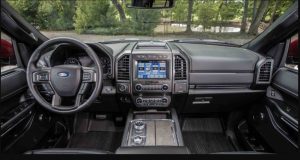
You can also get it as just the Expedition – sans the MAX – and same length (virtually) as a Tahoe. And it still comes standard with a stronger engine and more pulling power.
What It Is
The MAX is a longer version of the Ford Expedition – which is Ford’s full-size SUV. Unlike GM – which markets the Chevy Tahoe and Suburban as two different models – Ford markets the MAX as a version of Expedition rather than as two separate models, for the altogether sensible reason that the two are the same thing in different lengths.
Whether we’re talking about the Ford or the Chevys.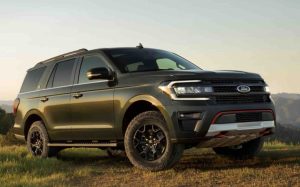
MAX prices start at $55,905 for the base XL trim with 2WD; adding the optional 4WD system bumps the price up to $58,955. From there you can select from XLT ($59,940), King Ranch ($77,170) and Platinum trims ($81,620). The latter comes standard with a stronger version of the 3.5 liter turbocharged V6 engine that’s standard in all Expeditions and this can be upgraded to an even stronger version if you select the optional Stealth package, which includes 22 inch wheels/tires, upgraded brakes, power deployable running boards and a 22 speaker premium audio system.
The Expedition’s main rivals are the Tahoe/Suburban but you might also want to look at the new Jeep Wagoneer and its longer iteration, the Wagoneer L. The regular Wagoneer is several inches longer than both the standard length Expedition and the Tahoe and it comes standard with a bigger – and stronger – V8 engine than comes standard in the Tahoe. The Wagoneer L is slightly longer than the Suburban – and comes standard with a twin-turbo inline six that’s stronger than the Expedition Max’s standard twin-turbo V6.
But both iterations of the Wagoneer also cost thousands more than either version of the Expedition as well as the Tahoe/Suburban. And besides, the Jeeps might not be the size you’re looking for.
What’s New For 2023
The longer MAX version of the Expedition is now offered with all trims, including the base XL.
What’s Good
MAX might be just the right size for your needs.
Standard twin-turbo V6 is more powerful than Chevy Tahoe/Suburban’s standard V8.
Gauges rather than displays; knobs rather than screens.
What’s Not So Good
Suburban is more spacious – in terms of cargo capacity – and comes standard with a V8.
Wagoneer comes standard with a higher (10,000 pound) tow rating.
Under The Hood
Unlike its rivals – which offer two or even three different engines – the Expedition comes with the same 3.5 liter V6, irrespective of trim (or length).
However, it does come in more than one output.
The base XL and next-up XLT trims come standard with a 380 horsepower version; the Limited, King Ranch and Platinums trims get a 400 horsepower version and there’s a 440 horsepower version available in the Limited as part of a Stealth Performance Package. The 440 horsepower version of the 3.5 liter V6 is also standard in the Timberline – an off-road/performance model added to the lineup last year that’s similar in theme to the Raptor version of the F-150 pick-up (the Expedition and F-150 share a common platform, or basic underlying layout).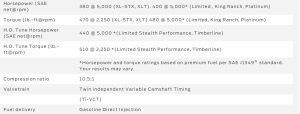
Even the base version of the 3.5 V6 is strong, in spite of its size.
As a point of comparison, consider the much larger 5.3 liter V8 that’s the standard engine in the Chevy Tahoe and its longer iteration, the Suburban. It produces 355 horsepower – and 383 ft.-lbs. of torque at 4,100 RPM. The Ford’s V6 makes 470 ft.-lbs. – at about half the engine speed (2,250 RPM). This is probably why the Chevy is rated to pull just 8,400 lbs. vs. 9,300 lbs. for the Ford. Torque matters when you’re pulling. It’s why diesels – which make more torque than horsepower – are preferred for pulling. Gas engines usually don’t make diesel-like torque (i.e., a lot of it, at low RPM) unless they are turbocharged.
And that’s why the Ford’s smaller engine comes standard with the the bigger tow rating.
Interestingly, the Tahoe and Suburban are available with a diesel engine – but its smallness (just 3.0 liters) reduces the two Chevys’ tow-rating to just 7,900 lbs. Chevy offers this engine as an economy engine – it carries an EPA rating of 21 city, 28 highway which is significantly higher than the 5.3 V8s’ 15 city, 20 highway (and the optional 6.2 liter, 420 horsepower V8’s 14 city, 18 highway).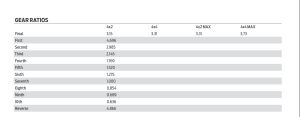
The Ford, meanwhile, carries a 16 city, 23 highway rating – splitting the mileage difference between its rivals’ gas V8s and turbodiesel six – while still out-pulling them all.
Interestingly, the Ford and the Chevys all use the same ten speed automatic transmission, which Ford and GM developed jointly, to reduce R&D costs. This is not unprecedented. Those old enough to remember (or who just know cars) will remember that AMC/Jeep vehicles often used Chrysler transmissions back in the ’70s.
The ten speed transmission has three overdrive ratios (8th, 9th and 10th gears) with tenth being a really deep 0.636 ratio that cuts engine revs down to about 1,700 RPM at 60 MPH, even with 3:31-3:73 gears in the rear axle, which would have resulted in the engine spinning at closer to 3,000 RPM at the same road speed – and probably about 8 MPG – if those overdrive gears weren’t there.
Something else you get with the MAX, by the way, is a larger (28 gallon) gas tank, which greatly increases this big rig’s range. It can travel an almost Prius-like 583 highway miles before needing more gas.
Jeep’s Wagoneer – a new model (using an old name) that came out last year – presents the Expedition (and the Tahoe/Suburban) with a new rival, one that comes standard with a bigger (5.7 liter) V8 than the Tahoe’s standard 5.3 liter V8 that also makes the most standard horsepower 392 as well as a very stout 404 ft.-lbs. of torque. The hunky Jeep also comes standard with a best-in-class 10,000 lb. tow rating and its EPA-rated mileage numbers – 16 city, 22 highway – are very competitive with the Ford’s and the two Chevrolets’. However, its base price – $58,995 – is about $3k higher than the Expedition MAX’s base price of $55,905.
On The Road
Ford probably doesn’t want you to know that this Ford does a very good job of emulating a Lincoln – the Navigator – which is the Expedition’s luxury-badged brother. Both are essentially the same vehicle – and feel like it. The Lincoln is slightly quieter, a bit softer – and it comes standard with a pair of the most indulgent massaging seats available (they’re better than the ones Mercedes installs in the S-Class sedan).And every Navigator comes standard with the 440 horsepower version of the 3.5 V6 that’s optional in the Expedition – so it’s stronger-feeling.
But it’s also $77,635 to start.
You can own something very similar for about $25,000 less to start. And you can get the massaging seats, if you want – along with the 440 horse engine, a very similar adaptive suspension a 22 speaker Bang & Olufsen audio system, deploying running boards and most of the rest that you’d get in a Navigator in a plain brown wrapper, so to speak.
This is similarly the case as regards the Tahoe and Suburban – which are the plain-brown-wrapper versions of the GMC Yukon and Cadillac Escalade. In the class, only the Jeep isn’t something else – or very much the same as something else.
But this is by no means a bad thing – as regards the Ford or the two Chevys – in that it’s a way to get the same (or very close to it) for a lot less.
If the Ford has any deficit, it is one shared with the Lincoln in that both have the same turbocharged engine that – sometimes – takes a long second (Trancers reference) to gather its strength before it moves. Even with two turbos – which are there to ameliorate this issue by building boost sooner than one turbo otherwise could – it still takes a long second for exhaust gas pressure to build and spin the turbos, to build boost. Most of the time, you will not notice any lag. But – sometimes – you will. Floor it from a dead stop and the Ford sometimes doesn’t react for what can feel like a long second, if you’ve got traffic coming up behind you. This is one area where V8s still rule – because they don’t need to exhale before they breathe.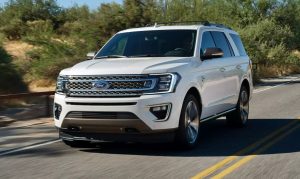
That small thing aside, there is little to fault. It is nothing less than amazing – even though we have become used to it – that a vehicle this big is not ponderous. It’s as easy to drive as a Camry – and a lot more comfortable, as body-on-frame and long-wheelbase vehicles generally are. Only in close quarters do you become aware of its length and width – and even then, it’s not difficult to maneuver.
That doesn’t mean you won’t need to maneuver. Parking spots (and parking lots) are designed for vehicles half this size.
But it’s not difficult to.
What you get with the MAX is more – and also, less.
Relative to the standard-length Expedition – which is 210 inches long – you get about a foot more Expedition. You also get 34.3 cubic feet of cargo space behind the third row whereas in the regular Expedition, just 20.9 cubic feet. Which is still a lot, which is one of the reasons why these big SUVs are so popular, relative to cars – which increasingly, aren’t. Even the big ones have very small trunks – relative to their size – and none can accommodate eight people, as the Expedition can.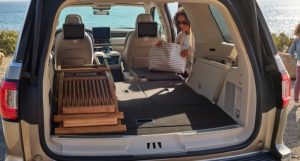
The Max can accommodate even more – stuff – with its second and third rows folded down, which increases the total available cargo carrying capacity to 121.5 cubic feet vs. 104.6 cubic feet in the standard-length Expedition.
And it can accommodate more easily. A Ford F-150’s bed is so high off the ground one needs a ladder to load and unload. Here, you don’t.
Now, the ‘Burban has even more capacity – for cargo (144.7 cubic feet) but it is also about half a foot longer (225.7 inches) and that might be a little too long for you. The Tahoe, on the other hand, isn’t as long as the MAX but it is has less space – leaving the Ford to (once again) split the difference.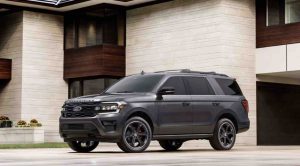
But the important difference, perhaps, might be the plain brown wrapper-ism mentioned earlier – which is an attribute also offered by the two Chevys. Even though this Ford can be 95 percent a Lincoln, it does not look it. That doesn’t mean it looks cheap. Far from it. But it does have a more demure look. This is a good look to have when you prefer not being looked at, which can be a good thing when you are driving in areas where people might be looking for “fancy” vehicles. Also, the Expedition looks a lot like the vehicles government heavies drive – because some do. And that might cause government heavies to not look at you.
As mentioned above, the Expedition does not come standard with a digital/LCD dashboard, which may make it preferable to you over the Lincoln, which comes standard with it. One of the things I liked very much about it is the fact that while Ford does install a secondary LCD touchscreen in the center stack, many of its functions (such as volume and station tuning) are controlled via functionally preferable knobs which do not require you to look at them in order to operate them.
There is also still a 12V power point point in accessible-to-the-driver location, just off to the right of the center console on the upper right portion of the dashboard (where you’ll also find a second/upper glovebox).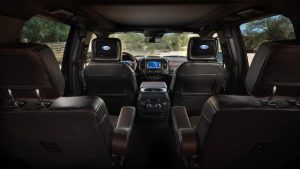
The Rest
One thing to be aware of is that Expedition does not come standard with a third row. The base XL only has two rows. Stepping up to the XLT adds the third row – and endows this rig with eight (rather than five) passenger-carrying capabilities.
Timberlines have almost 11 inches of standard ground clearance vs. 9.8 inches for the other trims. The top-of-the-line Platinum features Ford’s (and Lincoln’s) BlueCruise self-driving capability; but this capability is only operative on “supported” highways, meaning it doesn’t work on those that aren’t.
The Bottom Line
It’s not the biggest of the bunch – but it might be just big enough.
. . .
If you like what you’ve found here please consider supporting EPautos.
We depend on you to keep the wheels turning!
Our donate button is here.
If you prefer not to use PayPal, our mailing address is:
EPautos
721 Hummingbird Lane SE
Copper Hill, VA 24079
PS: Get an EPautos magnet or sticker or coaster in return for a $20 or more one-time donation or a $10 or more monthly recurring donation. (Please be sure to tell us you want a magnet or sticker or coaster – and also, provide an address, so we know where to mail the thing!)
My eBook about car buying (new and used) is also available for your favorite price – free! Click here. If that fails, email me at [email protected] and I will send you a copy directly!


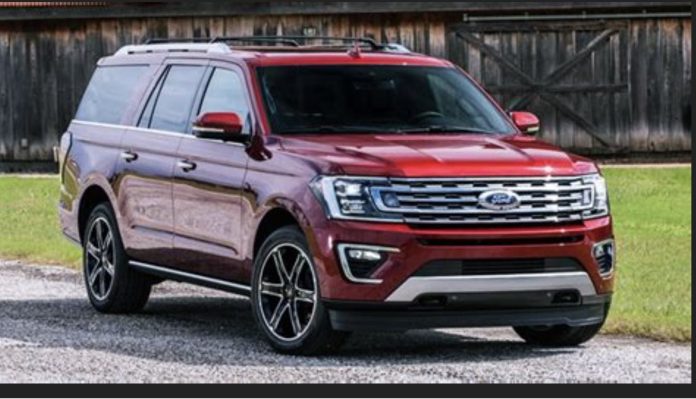

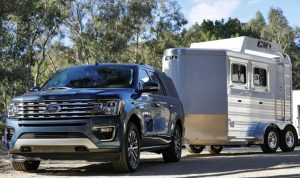
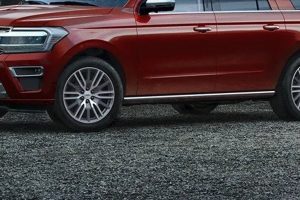








In mid-1948, the first postwar US auto design — the 1949 Ford — was called a ‘shoebox’ for its slab-sided look.
As the top photo of a red Expedition shows, nothing has changed. It’s just a square box with windows and wheels. Not exactly ugly, but hardly inspiring either: a kind of SUV fishwife, to be endured for practical reasons, even if she weighs a hefty 5,800 lbs.
Just don’t let her roll over and crush you like a bug.
Great review and comparison of the big boys. Best I’ve seen. Well done Eric.
You could probably lump all the big pickups in there as well as they are similar except the bed part.
I have a hard time paying these prices purely on principal. 80K for a truck? Get outta here
We rented one (loaded XLT) of these a couple times in the last year. Once it handled six people and all their luggage easily. The other time it hauled two people and a whole lot of stuff being moved from NY to NC and TN. Both times it performed flawlessly exceeding expectations for economy, range, and comfort.
It’s amazing the difference in cost for the top and bottom trim levels, each retaining the same powertrain. (either exactly the same, or essentially the same.) $59k for 4wd XL and $82k for top of the line trim. That $23k difference is another car! (sadly, though used…) Sheesh, my 2020 F150 XL 4wd ecoboost was $31k out the door at the height of covid. Absolutely cant touch that today!
My wife wants a new Outback, and heated seats are a MUST for her, unfortunately. So, to get that from the factory, have to go with at least the Premium model, vs the base. However, have thought about Base with aftermarket, professionally installed touche-toasters.
I couch everything in terms of powertrain. That, I’ll pay $$ for. But “bells-and-whistles”, arent worth it. And when they break, then wife gets dissatisfied with the damn car, no matter how reliable it is.
If you want big, a local friend drives an Excursion with the Triton V-10.
I usually see him driving his Unimog, though. He’s not really into small and efficient.